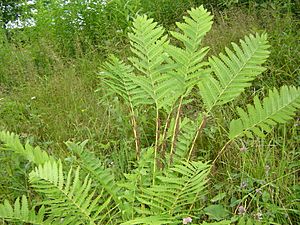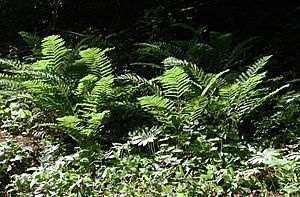Claytosmunda facts for kids
Quick facts for kids Claytosmunda |
|
|---|---|
 |
|
| Conservation status | |
| Scientific classification | |
| Synonyms | |
|
(genus)
(species)
|
The Claytosmunda is a type of fern. It has only one known species, called Claytosmunda claytoniana. This fern is also known as the interrupted fern. You can find it growing naturally in Eastern Asia, the Eastern United States, and Eastern Canada.
The fern's scientific name, claytoniana, honors an English botanist named John Clayton. The common name "interrupted fern" comes from how its middle leaves fall off. This leaves a gap in the middle of the fern's frond, making it look "interrupted."
Scientists have found fossils of this fern in Europe. This shows that it used to grow in many places around the northern parts of the world. Fossils that look like Claytosmunda claytoniana have been found from as far back as the Triassic period. This means the fern has stayed almost the same for at least 180 million years!
Contents
Description
The leaves of the Claytosmunda claytoniana fern are called fronds. They are usually about 40 to 100 centimeters (16 to 39 inches) tall. They are also about 20 to 30 centimeters (8 to 12 inches) wide. Each frond is made of many smaller parts that grow in an arching shape. The frond gets narrower towards its pointed tip. The bottom part is also a bit thinner because its first segments are shorter.
In the middle of the frond, there are three to seven special, short, cinnamon-colored parts. These are the fertile parts that hold the spores. After these parts release their spores, they wither and fall off. This creates the "interrupted" gap that gives the fern its name.
Without these special middle parts, the interrupted fern looks a lot like the cinnamon fern. You can tell them apart by looking closely at the base of their leaf segments. Cinnamon ferns have many soft, felt-like hairs. Interrupted ferns have very few hairs, and they are so short you might need a magnifying glass to see them.
Like other ferns in its family, this plant has a very large rhizome. A rhizome is an underground stem. Old leaf bases stay on the rhizome from previous years. The fern grows in small, thick groups, spreading slowly through its rhizome. Sometimes, it even forms fairy rings.
Where It Lives
North America
In eastern North America, you can find this fern in many places. It grows around the Great Lakes region. In eastern Canada, it's found in southern Manitoba, Ontario, and Quebec. It also grows east to Newfoundland.
In the eastern United States, it's common in upper New England. It spreads south through the Appalachian Mountains and along the Atlantic coast. You can find it in the Southeastern United States in Georgia and Alabama. It also grows west across the Southern United States to the Mississippi River. From there, it goes back up through the Midwestern United States to the Great Lakes.
Asia
In eastern Asia, the interrupted fern lives in both warm, subtropical and cooler, temperate areas. It is found in the Eastern Himalaya mountains. You can also see it in South Central China and Eastern China. It grows on Taiwan, the Korean Peninsula, the Ryukyu Islands, and in Japan.
Its Home Environment
Claytosmunda claytoniana likes places that are humid, or damp. It mostly grows in forests. However, you can also find it in more open areas. It rarely grows in bogs. The interrupted fern is often found growing near other ferns. These include the ostrich fern, cinnamon fern, and sensitive fern.
Plant Family & History
Ancient Ferns
The interrupted fern is a great example of a plant that has not changed much over time. Scientists have found fossils of this fern that are at least 180 million years old. These ancient fossils look almost exactly like the ferns we see today. This shows how incredibly stable this plant has been through millions of years of Earth's history.
Naming the Fern
The interrupted fern was first described by a famous scientist named Carl Linnaeus in 1753. He named it Osmunda claytoniana. In 2005, scientists realized this fern was a bit different from others in the Osmunda group. So, they placed it in its own special subgroup. Then, in 2016, this subgroup was made into a completely new genus, or group, called Claytosmunda. This is why its full scientific name is now Claytosmunda claytoniana. Some plant databases now use this new name. Others still place it in the genus Osmundastrum. This shows how scientific understanding of plant families can change over time.
Hybrid Ferns
Sometimes, two different types of ferns can create a new fern called a hybrid. Osmunda × ruggii is a hybrid fern. It is a mix between C. claytoniana (interrupted fern) and O. spectabilis (American royal fern). This hybrid is important to scientists. It suggests that the interrupted fern is more closely related to the American royal fern than to the cinnamon fern. This discovery helped scientists decide to move the cinnamon fern into its own genus, Osmundastrum. The Osmunda × ruggii hybrid fern cannot reproduce. It is very rare and has only been found in about two natural places.
How It's Used
For Health
The Iroquois people, a group of Native Americans, used the interrupted fern. They used it as a treatment for problems with blood.
For Food
Unlike the ostrich fern, the young curled shoots of the interrupted fern, called fiddleheads, are not usually eaten. They have a bitter taste and can cause stomach upset. However, the very young buds and the base of the stem can be eaten. It's important not to pick too many, as this could harm the plant.
In Gardens
Claytosmunda claytoniana is grown as an ornamental plant. This means people grow it because it looks nice. It's used in traditional gardens and in gardens that feature native plants. It's also good for wildlife gardens and for restoring natural areas. Because it spreads and forms groups, it can help hold soil on slopes and prevent erosion.




